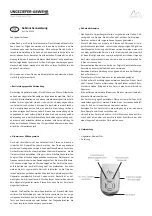
58
The EH
Pro
actuator has the facility to accept 4 auxiliary inputs (AUX1–AUX4). These
are used when supplementary remote control or volt free digital auxiliary inputs are
required in addition to the standard control and feedback features incorporated
into the DeviceNet module. It is also possible to have a combination of both remote
control and volt free inputs to provide, for example, open and close control as well
as a high and low tank level alarm indication, supplied via an external transducer.
The hexadecimal number displayed under PF can be considered as a ‘‘software
mask’’. It is this mask that tells the DeviceNet module what type of input to expect,
control or input signal, and what form the input will be, normally open or normally
closed.
To decipher the mask the number needs to be split into two separate hexadecimal
characters, each of which can be sub-divided into 4 binary bits. The first 4 bits
represent the function and the second 4 represent the input source (known as
invert). Pictorially this can be represented as:
Left side hex character
Right side hex character
Aux 4 to 1 (function)
AUX 4 to 1 (Invert)
Bits
4 3 2 1
4 3 2 1
When used for remote control of the actuator bits 4 to 1 of the function character
have been designated as follows:
Bit 4
(AUX4)
–
ESD
Bit 3
(AUX3)
–
Stop (Maintain)
Bit 2
(AUX2)
–
Close
Bit 1
(AUX1)
–
Open
(When used for digital signal inputs they are simply designated as AUX 4 to AUX 1.)
Rules
1. Function bit set to ‘‘0’’
Any function bit set to ‘‘0’’ indicates that the particular aux input is to be treated as
a digital signal for field status reporting, e.g. a level switch or motor running status.
If the corresponding invert bit is set to a "0", an open contact is reported as a logic
‘‘1’’ and a close contact is reported as a logic ‘‘0’’ (i.e. this will invert the input).
If the corresponding invert bit is set to a ‘‘1’’, an open contact is reported as a logic
"0" and a close contact is reported as a logic ‘‘1’’ (i.e. this gives a non-inverting
input).
2. Function bit set to ‘‘1’’
Any function bit set to ‘‘1’’ indicates that the particular aux input is to be treated as
a digital command to operate the actuator.
When the corresponding invert bit is set to a "0" this represents an N.C. contact
as being the command source, i.e. a closing contact de-energises the input and an
opening contact energises the input.
When the corresponding invert bit is set to a ‘‘1’’, this represents an N.O. contact
as being the command source, i.e. a closing contact energises the input and an
opening contact de-energises the input.
3. ESD Control
When using ESD (aux input 4), the ESD contact mode setting
[A2]
should be set to
the default value of
[
n
O]
. The
[A1]
– ESD direction setting should be set to either
open or close the valve
(refer to section 9.5)
.
4. Stop (Maintain) Control
When energised this will make the Aux input Open/Close control push-to-run.
When de-energised, the Aux input Open/Close control will be maintained. ESD is
always push to run (non maintained).
PF
DeviceNet Remote
Auxiliary Input
















































